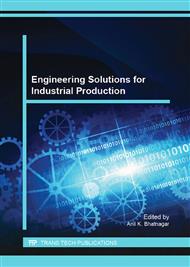[1]
Bejan, A. Transferência de Calor, Editora Edgard Blücher Ltd., Brazil, 1996. in portuguese.
Google Scholar
[2]
Arpaci, V. S. Conduction Heat Transfer. Addison-Wesley Publishing Company, 550p. (1966).
Google Scholar
[3]
M. R. Vujicic and S. G. R. Brown. Iterative Solvers in the Finite Element Solution of Transient Heat Conduction. FME Transactions, vol. 32, pp.61-68. (2004).
Google Scholar
[4]
De Campos, M. D., Romão, E. C., De Moura, L. F. M. A Finite-Difference Method of High-Order Accuracy for the Solution of Transient Nonlinear Diffusive-Convective Problem in Three Dimensions. Case Studies in Thermal Engineering, v. 3, pp.43-50, (2014).
DOI: 10.1016/j.csite.2014.03.001
Google Scholar
[5]
Catabriga, L., Valli, A. M. P., Melotti, B. Z., Pessoa, L. M. and Coutinho, A. L. G. A. Performance of LCD iterative method in the finite element and finite difference solution of convection–diffusion equations. Commun. Numer. Meth. Engng, vol. 22, p.643–656. (2006).
DOI: 10.1002/cnm.842
Google Scholar
[6]
Asensio, M. I., Ayuso, B. and Sangalli, G. Coupling stabilized finite element methods with finite difference time integration for advection–diffusion–reaction problems. Comput. Methods Appl. Mech. Engrg, vol. 196, p.3475–3491. (2007).
DOI: 10.1016/j.cma.2007.03.016
Google Scholar
[7]
Romão, E. C., Moura, L. F. M. 3D contaminant transport by GFEM with hexahedral elements. International Communications in Heat and Mass Transfer, v. 42, pp.43-50, (2013).
DOI: 10.1016/j.icheatmasstransfer.2012.10.016
Google Scholar
[8]
Neves, O. A., Romão, E. C., Silva, J. B. C., Moura, L. F. M. Numeric simulation of pollutant dispersion by a control-volume based on finite element method. International Journal for Numerical Methods in Fluids (Print), v. 66, pp.1073-1092, (2011).
DOI: 10.1002/fld.2296
Google Scholar
[9]
Jiang, B. N. The Least-Squares Finite Element Method. Theory and Applications in Computational Fluid Dynamics and Electromagnetics, Springer, (1998).
DOI: 10.1007/978-3-662-03740-9_14
Google Scholar
[10]
Romão, E. C., Martins, J. A., Moura, L. F. M. Least Squares Finite Element Method for 3D Unsteady Diffusion and Reaction-Diffusion problems. WSEAS Transactions on Fluid Mechanics, v. 9, pp.196-209, (2014).
Google Scholar
[11]
Reddy, J. N. An Introduction to the Finite Element Method, Second Edition, McGraw-Hill, (1993).
Google Scholar
[12]
Romão, E. C. 3D Unsteady Diffusion and Reaction-Diffusion with Singularities by GFEM with 27-Node Hexahedrons. Mathematical Problems in Engineering, Vol. 2014, Article ID 560492, 12 pages.
DOI: 10.1155/2014/560492
Google Scholar


